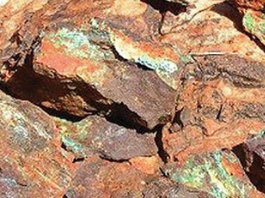
 | Metal ore deposits - Where does the copper go? |
Metals such as copper and cobalt have many applications including fields such as green energy. But finding new sources of supply is tricky. Metals, like other minerals, are passed from the mantle to the Earth's crust during magmatic episodes, such as volcanic eruptions. However, the mechanisms and the conditions required to release metals from the mantle are still poorly understood. For example, earlier studies have shown that the bulk of the continental crust is relatively low in copper (Cu) and has a lower copper/silver (Cu/Ag) ratio than do basaltic arc magmas or mid-ocean ridge basalts. But it is unclear how the copper has gone missing from the mineral mix.
In 2020 a geologist called Chan published with his colleagues the results of their study of Arizona garnet-pyroxenite xenoliths. (A xenolith is a rock fragment that has become enveloped in a larger rock during the latter's development and solidification within the ascending magma during its emplacement and eruption.) The xenoliths studied represent cumulates formed in a deep continental arc.
Chan and his co-workers showed that many of these cumulates are rich in copper. Furthermore these cumulates have higher Cu/Ag ratios than basaltic arc magma. (see ref 1). The concentration of copper and silver is not high initially but begins to rise with increased amounts of sulfide and peaks following sulfide saturation. The researchers theorized that the bulk of copper extracted from the magma in a continental arc may be sequestered in sulfides at the base of the continental crust and the sulfide-bearing cumulates, with their high copper concentrations and high Cu/Ag ratios, represent the missing copper reservoir.
As the co-author of a more recent study, Dr Iain McDonald, explained: "When magmas reach the base of the continental crust the critical metals often get trapped here and do not reach the surface if the temperature is either too hot or too cold."
So it appears that the Earth has large reservoirs of metals sequestered under the continental crust. The problem is that the crust is about 25 km thick so direct mining at this depth is not possible. But we also know that magmatic arcs (a chain of volcanoes formed above a subducting plate positioned in an arc shape) are the most significant factories for generating continental crust and these host our main deposits of metals - in particular porphyry-epithermal Cu-Au-Mo deposits.
Porphyry copper deposits are the most distinctive hydrothermal deposits. They contain a large volume of shattered rock with a network of tiny quartz veins.Grains of the copper ore chalcopyrite (the most common copper mineral, a copper and iron sulfide) and bornite (bornite is a copper-ore mineral, copper and iron sulfide (Cu5FeS4)) occur with pyrite. "Epithermal" is a term used to classify hydrothermal deposits based on the temperature and depth of deposition. It is used in field exploration studies to describe Au, Ag and Cu deposits formed in magmatic arc environments.
This research suggests that from time to time active subduction zones create prolonged mafic magmatism which results in higher temperatures.This creates ideal conditions for Cu-Au-Mo rich sulfides to be transported to the surface within the mafic magma.
To discover the right conditions for releasing and transporting copper from the subcontinental reservoirs, a team led by researchers from Cardiff University has been analyzing samples from the Sella Bassa mine in Piemonte, Northern Italy. This mine, which was active in the 1870s, has a typical magmatic iron-copper-nickel (Fe-Cu-Ni) deposit. The area, which is called Ivrea-Zone, represents a section through the lower continental crust which has been tilted into its present position during the Alpine orogeny (a process in which a section of the earth's crust is folded and deformed by lateral compression to form a mountain range.). So the samples collected from the mine are good examples of material usually trapped at the base of the Earth's crust.
The team showed that when the Fe-Cu-Ni ore deposits are heated to about 1000-1200 degrees centigrade, Cu-Au rich sulfides turn into liquid, whereas Ni-Fe rich sulfides remain in the solid phase. The liquified sulfides are then mobilized to ascend through the lithosphere providing metals for porphyry and epithermal ore deposits.
"We have discovered that if the temperature is 'just right' at around 1000°C, then metals like copper, gold and tellurium can escape the trap and rise up towards the surface to form ore deposits." - McDonald explains.
The authors hope that their study will enable more targeted mineral exploration and help to pinpoint new reserves of copper.
Journal Reference:
| _______________________________ | ||||
| Home | | | Shopping | | | Database |
© Biscuit Software 2004-2019
All rights reserved